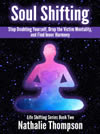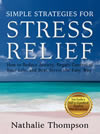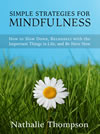 Worrying is one of those double-edged swords; on the one hand, a little bit of worrying can be helpful, in the sense that it can keep you alert and on your toes, and spur you on to take action that could help you avoid negative situations. But on the other hand, too much worrying can really have a detrimental effect on both your mental and physical health. Figuring out when that line between “a little bit” and “too much” gets crossed, and learning how to stop worrying when you want to is what today’s post is all about…
Worrying is one of those double-edged swords; on the one hand, a little bit of worrying can be helpful, in the sense that it can keep you alert and on your toes, and spur you on to take action that could help you avoid negative situations. But on the other hand, too much worrying can really have a detrimental effect on both your mental and physical health. Figuring out when that line between “a little bit” and “too much” gets crossed, and learning how to stop worrying when you want to is what today’s post is all about…
How to tell if you’re worrying too much
If your worrying is short-lived, kicks you into action to solve a problem, and then subsides when the specific problem is dealt with, then you’re OK. But if your worrying is chronic and you find yourself constantly going over “what-if” scenarios and imagining the worst possible outcome to any situation, then worrying is a problem. Unchecked worrying of the latter sort can cause your anxiety levels to soar, locking you into a downward spiral of self-doubt, fear, and even outright depression. It’s hard to feel good about your life when you’re always thinking about doomsday possibilities to everything!
How to stop worrying: 5 Strategies for Success
Fortunately, worrying is just another mental habit. And habits can be changed. It’s just a matter of shifting your thoughts. So with that in mind, here are five strategies that you can start using today to help you learn how to stop worrying now:
Tip #1: Distract Yourself. When you realize that a worrying thought has taken hold of you, distract yourself with something else. Get busy working on your “to-do” list of stuff you know you can actually do something about – put that worrying energy to good use and get stuff done! Alternatively, call a friend, watch a funny movie or read a book. Try listening to some upbeat music to help shift yourself into a better feeling mood. Just do something (anything!) that will shift your focus onto something other than what you’re worrying about.
Tip #2: Schedule It. If you’re really prone to worrying throughout the day, then train yourself to postpone your worrying to a specific daily “worry time”. Put your worry time into your schedule and try to keep it at the same time and place every day (just be sure not to schedule it too close to bedtime or you’ll just find yourself too anxious to sleep!). Give yourself 15 or 20 minutes to do all your best worrying, and ONLY worry during this time. When a worry comes up during the day, write it down and save it for your worry time. This gets easier the more you do it, and as you get better at it, you’ll start to realize that you have more power over your own thoughts than you realized, which itself has a worry-busting effect all on its own.
Tip #3: Be Here Now. Most of our worrying is about stuff that might happen in the future, or involves reliving stuff that already happened in the past. Practising mindfulness by focusing on the present moment helps to keep you grounded in the only time over which you have any control – what’s happening right now. Life happens in the now, and making it a point to remind ourselves of that when we get caught up in the past or the future is a good way to help diffuse those anxious worrying feelings.
Tip #4: Find Stillness. It seems that every moment of our waking lives is filled up with stuff these days. We’re constantly doing things – we’re on our smart phones, we’re checking our email, we’re surfing the Internet, we’re reading, we’re watching, we’re listening, we’re talking… we are always distracted by something. But when we can find ourselves moments of stillness and silence, the space to just breathe and be… this stillness has a powerful ability to reconnect us with our centre and allow us to hear that voice within once again.
Tip #5: Imagine a Happy Ending. If there is a particular problem that has you in a knot, then use the power of your own mind and visualize the outcome that you would most like to see. Instead of worrying about all the bad possibilities, focus on what the best possible outcome would be – get detailed and put yourself in the picture. Focus on that happy ending and believe that this is what will happen.
Worrying is a stressful and unpleasant state of mind to be caught up in. But learning how to stop worrying with effective vibe shifting strategies and techniques like those above can get us back on track again.
photo credit: (c) Can Stock Photo

















If only it were this easy! Some go further than worry into the dark realm of regret where even worse things happen. The brain loves to go over stuff, thinking it’s doing you a favor but it’s really not. Worry has terrible effects on health, so it is best to ease your worries as best you can and eventually you will be more free of them.
Regret just leads to depression. What’s done is done, and you can’t go back and change it. What you can do is focus yourself on what you want to build right now. You made the best decision then that you could based on your experience, your knowledge and your inner strength at the time. You did the best you could. You’re a different person now — you have more life experience, you know stuff you didn’t know then, and you’re stronger because of it all. You can use that to create whatever you want now, if you’re willing to let yourself. It’s hard to build anything awesome, though, if your hands are full with old baggage…
So yes, ease your worries however you can. If these strategies don’t resonate with you, then there are many others out there that can also help. It’s a matter of finding what works best for you. Everyone is different and not every strategy will work for ever individual. That’s why I always like to list a few different ones for people to try. 🙂